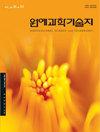The Characteristics of Small-Sized Watermelons in Quality and Yield according to Planting Density, Stem Number, and Node Number of Fruit-Setting
IF 0.8
4区 农林科学
Q3 HORTICULTURE
Korean Journal of Horticultural Science & Technology
Pub Date : 2023-06-30
DOI:10.7235/hort.20230023
引用次数: 0
Abstract
There is a rapid change in the preference of watermelons from large-sized ones (6 kg or more) to small-sized ones (2–4 kg), however research on the cultivation techniques for small-sized watermelons is insufficient. In order to cultivate high-quality small-sized watermelons, this study was done to ascertain the planting density, stem number, and node number of fruit-setting methods. The ‘Banjeonmaeryuk’, a long and elliptical small-sized watermelon variety that grown in South Korea was grafted to ‘Bullojangsaeng (Lagenaria siceraria Standley)’ with its characteristics in growth, development and yield analyzed according to plant density and stem number. The results showed that the group cultivated at 1,333 plants/10a, three stem training sessions in planting density, and 130 leaves made a 2.6% increase in the marketable rate and 4.5% in the amount than the group cultivated at four stems under the same transplanting distance with the same fruit weight at 3.4 kg. As for the fruit- setting node order of small-sized watermelons, when two pieces of fruit were set in the third female flower (fruit-setting node: 19–20) of the second stem of three, it recorded an 85% fruit-setting rate, 11.5°Brix of sugar content, and 16–20 more in amount than other fruit-setting methods. In addition, the study examined three varieties of small-sized watermelons in fruit quality and amount to test the productivity of cultivation techniques for small-sized watermelons and found that one fruit per stem recorded as high as 97.5% average fruit-setting rate, an average fruit weight of 3.2 kg, and that two fruits per stem recorded 35.4–82.6% fruit-setting rate, which shows big differences among the different varieties. When two pieces of fruit were set per stem, the resulting fruit weight dropped down to an average of 1.8 kg. The three varieties recorded an average yield of 4,559 kg/10a, and a high sugar content of 11.6°Brix. These findings indicate that one can cultivate high-quality small-sized watermelons in large amounts by setting the transplanting distance at 30 cm, training three stems, and setting two pieces of fruit in the third female flower at the same time.种植密度、茎数和坐果节数对小西瓜品质和产量的影响
人们对西瓜的偏好从大西瓜(6公斤以上)迅速转变为小西瓜(2-4公斤),但对小西瓜栽培技术的研究却不足。为了培育优质小西瓜,本研究确定了坐果方法的种植密度、茎数和节数。将韩国产的长椭圆形小型西瓜品种‘Banjeonmaeryuk’嫁接到‘Bullojangsaeng (Lagenaria siceraria Standley)’上,根据植株密度和茎数分析其生长发育和产量特征。结果表明,在相同移栽距离、相同果重3.4 kg条件下,以1333株/10a、种植密度3次、130片叶片栽培组的商品率和数量比以4根茎栽培组提高2.6%和4.5%。小型西瓜的坐果节顺序,在3根第二茎的第3朵雌花(坐果节:19-20)上坐果2片,坐果率为85%,含糖量为11.5°Brix,坐果量比其他坐果方法多16-20。此外,本研究还对3个小西瓜品种的果实品质和数量进行了检验,以检验小西瓜栽培技术的生产力,结果发现,每茎1个果实的平均坐果率高达97.5%,平均坐果重达3.2 kg,每茎2个果实的坐果率为35.4-82.6%,不同品种间差异较大。当每根茎上放两片果实时,结果果实的重量下降到平均1.8公斤。这三个品种的平均产量为4559公斤/10a,含糖量高达11.6°Brix。上述结果表明,将移栽距离设定为30 cm,培养3根茎,在第3株雌花上同时定植2片果实,可以培育出大量优质的小型西瓜。
本文章由计算机程序翻译,如有差异,请以英文原文为准。
求助全文
约1分钟内获得全文
求助全文
来源期刊
CiteScore
2.00
自引率
0.00%
发文量
0
审稿时长
1 months
期刊介绍:
Horticultural Science and Technology (abbr. Hortic. Sci. Technol., herein ‘HST’; ISSN, 1226-8763), one of the two official journals of the Korean Society for Horticultural Science (KSHS), was launched in 1998 to provides scientific and professional publication on technology and sciences of horticultural area. As an international journal, HST is published in English and Korean, bimonthly on the last day of even number months, and indexed in ‘SCIE’, ‘SCOPUS’ and ‘CABI’. The HST is devoted for the publication of technical and academic papers and review articles on such arears as cultivation physiology, protected horticulture, postharvest technology, genetics and breeding, tissue culture and biotechnology, and other related to vegetables, fruit, ornamental, and herbal plants.

 求助内容:
求助内容: 应助结果提醒方式:
应助结果提醒方式:


